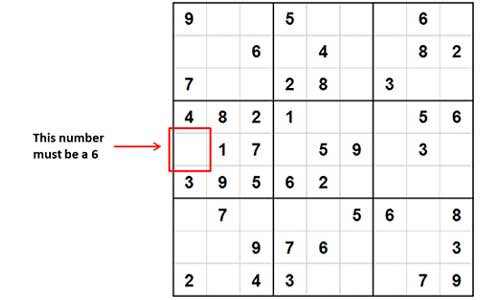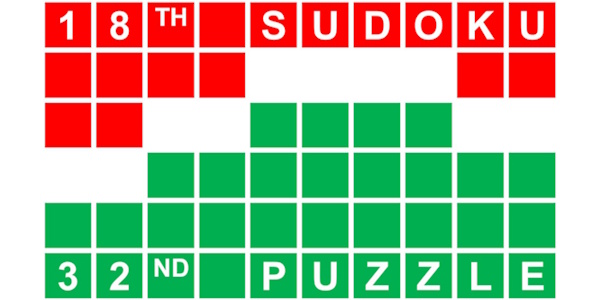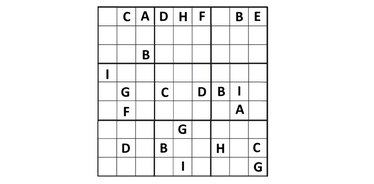Look for areas with easy solutions (hanging fruit)
Try to find the easiest place to write the number. This is typically a square, row, or column where most of the numbers are already filled in. All that's left is to write one. For instance, you have a square with the numbers 2, 3, 4, 5, 6, 7 and 8. A quick analysis suggests that you need to write in cells 1 and 9. As a general rule, this kind of lifehack almost always works in Sudoku for beginners.
I've included an example below of what I call 'hanging fruit'. The square in the top left-hand corner contains the numbers 4, 8, 2, 1, 7, 9, 3 and 5. So, all that's left to do is fill in one cell with the missing digit. In our case, it's 6. Once we've inserted the 6 into the square, let's see what happens in the column and in the row. The column contains 9, 7, 4, 6, 3, 2. The row contains 6, 1, 7, 5, 9, 3. There doesn't seem to be a clear solution as to which numbers should be inserted. Let's move on and take a look at some other sections.

Use the elimination method
When it comes to both easy and hard Sudoku, it's best to use the method of elimination. In other words, you need to check which numbers are already in the row/column/square. The rules of the puzzle are based on the fact that the numbers should not be repeated.
So, we look at what numbers are missing, not just in the target row but also in the column and square. For instance, the bottom row has 7, 4, 9, 6, 1 and 5. We can put a 2, 3 or 8 in the three empty cells. We can see that we already have a 2 in the penultimate column (7, 5, 2, 9, 6). So, either 3 or 8 can go in the row.

Not guessing, thinking
The idea behind Sudoku is that there's no room for guesswork. The more numbers you put in the cells on the left, the harder it is to work out the truth. If you're not sure whether the number fits the square or row, it's probably best to move on to another sector.
Move even if things are difficult
If you're looking for a puzzle that rewards a "keen eye", Sudoku is a great choice. It often seems like the process of unravelling is stuck. If you're struggling with a square, try moving to another sector. If you feel like you're not making progress, you can put Sudoku aside and take a break.
As a general rule, there are no unsolvable sections in Sudoku. It's likely that you just didn't spot something. Start looking at the areas where there are no numbers. You might be able to spot patterns and uncover a "potential clue".
Think carefully about every change
Let's say you put a new number on the grid. It's not just the row that's been affected, either. The changes have also impacted the column and the squares. Take a couple of minutes to think about what's changed and what values you can add.
Each new number gives you the option of putting more numbers in neighbouring rows, squares and columns. This makes the puzzle quicker to solve.
Sudoku is a fun way to exercise your brain. It gets you thinking and uses logic. The game is designed to get the left side of your brain working. But it's also good for keeping your mind flexible and your thinking clear, even as you get older.
What tips do you use to solve Sudoku? Let us know in the comments!



